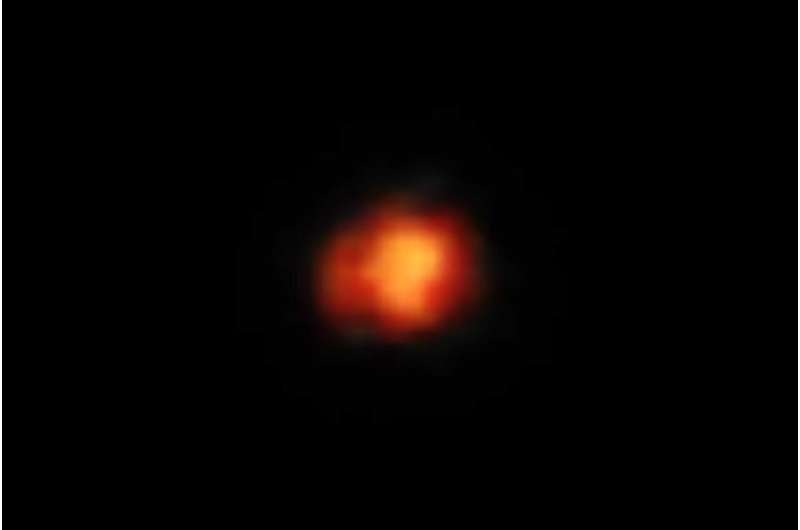This article has been reviewed according to Science X's editorial process and policies. Editors have highlighted the following attributes while ensuring the content's credibility:
fact-checked
peer-reviewed publication
trusted source
proofread
Astronomers confirm Maisie's galaxy is among earliest ever observed

Thanks to the James Webb Space Telescope, astronomers racing to find some of the earliest galaxies ever glimpsed have now confirmed that a galaxy first detected last summer is in fact among the earliest ever found. The findings are published in the journal Nature.
Follow-up observations since first detection of Maisie's galaxy have revealed that it is from 390 million years after the Big Bang. Although that's not quite as early as the team led by University of Texas at Austin astronomer Steven Finkelstein first estimated last summer, it is nonetheless one of the four earliest confirmed galaxies observed.
"The exciting thing about Maisie's galaxy is that it was one of the first distant galaxies identified by JWST, and of that set, it's the first to actually be spectroscopically confirmed," said Finkelstein, a professor of astronomy at UT Austin, an author of the Nature paper and the principal investigator for the Cosmic Evolution Early Release Science Survey (CEERS). He named the galaxy after his daughter as it was discovered on her birthday.
The latest analysis was led by first author Pablo Arrabal Haro, a postdoctoral research associate at the National Science Foundation's National Optical-Infrared Astronomy Research Laboratory. Besides Finkelstein, co-authors from UT Austin are Caitlin Casey, Micaela Bagley, Katherine Chworowsky and Seiji Fujimoto.
The CEERS team is currently evaluating about 10 other galaxies that might be from an era even earlier than Maisie's.
Objects in space don't come printed with a time stamp. To infer when the light we observe left an object, astronomers measure its redshift, the amount that its color has been shifted due to its motion away from us. Because we live in an expanding universe, the farther back in time we look, the higher an object's redshift.
The original estimates of redshifts (and hence times after the Big Bang) were based on photometry, the brightness of light in images using a small number of wide frequency filters. Those estimates were made using data collected by CEERS during its originally allotted time for the telescope's first observing season.
To get a more accurate estimate, the CEERS team applied for follow-up measurements with JWST's spectroscopic instrument, NIRSpec, which splits an object's light into many different narrow frequencies to more accurately identify its chemical makeup, heat output, intrinsic brightness and relative motion. According to this latest spectroscopic analysis, Maisie's galaxy is at a redshift of z=11.4.
This study also looked at CEERS-93316, a galaxy originally found in publicly available CEERS data by a University of Edinburgh-led team and was initially estimated to have been observed at a jaw-dropping 250 million years after the Big Bang. On further analysis, the team found that CEERS-93316 has a more modest redshift of z=4.9, which corresponds to about 1 billion years after the Big Bang.
It turns out that hot gas in CEERS-93316 was emitting so much light in a few narrow frequency bands associated with oxygen and hydrogen that it made the galaxy appear much bluer than it really was. That blue cast mimicked the signature Finkelstein and others expected to see in very early galaxies. This is due to a quirk of the photometric method that happens only for objects with redshifts of about 4.9. Finkelstein says this was a case of bad luck.
"This was a kind of weird case," Finkelstein said. "Of the many tens of high redshift candidates that have been observed spectroscopically, this is the only instance of the true redshift being much less than our initial guess."
Not only does this galaxy appear unnaturally blue, it also is much brighter than our current models predict for galaxies that formed so early in the universe.
"It would have been really challenging to explain how the universe could create such a massive galaxy so soon," Finkelstein said. "So, I think this was probably always the most likely outcome, because it was so extreme, so bright, at such an apparent high redshift."
More information: Pablo Arrabal Haro et al, Confirmation and refutation of very luminous galaxies in the early universe, Nature (2023). DOI: 10.1038/s41586-023-06521-7 www.nature.com/articles/s41586-023-06521-7
Journal information: Nature
Provided by University of Texas at Austin





















